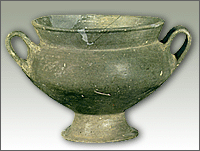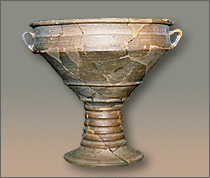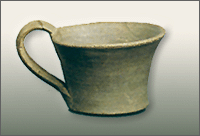 |
||
| Minyan pottery is the most typical Middle Helladic ceramic ware. Its first examples appeared already from the Early Helladic III period (2300-2000 BC). This pottery was named after Minyas, the mythical king of Orchomenos, since Minyan ceramics were first unearthed in the Middle Helladic strata of this settlement. Minyan ceramics were either handmade or wheelmade. The fine traces of the potter's wheel visible on the surface of the vases show that this type of pottery was manufactured with a more advanced and faster wheel than the other ceramic wares. The various colours of the surface of Minyan ceramics have been acquired through different firing conditions. The Gray Minyan ware has been achieved by firing in reducing atmosphere. Conversely, the Yellow and Red Minyan have acquired these colours by oxidized conditions. Another typical trait of Minyan vases is the so-called "soapy" feel of their surface which is due to their hardness and to their careful burnishing. |
 |
|
|
Two-handled gray Minyan
bowl
with high stem from Thebes. |
||
|
Central Greece is considered to have been the main production centre of Minyan pottery since it is the region where the largest quantities, many Minyan varieties and the most authentic examples occur. The examples found in areas far from the production centres are of a lower quality in comparison to those of Central Greece. This reveals that imitations were often made. The Minyan pottery of the Peloponnese appears quite differentiated from Central Greece. A special variety with gray-brown surface and coarse roseate clay is named "Argive" Minyan pottery. The manufacture of Minyan pottery demanded great effort from the potters. Thus, their production was almost exclusively devoted to the manufacture of fine tableware drinking vessels. There are also Minyan vessels of lower quality with many stone inclusions but no large storage vases and vessels. All the Minyan vase shapes have been given a very typical intense angular contour which suggests vases made of metal sheets. This led many researchers to suggest that Minyan vase shapes are inspired from the metal vases and that Minyan pottery may have been a cheaper substitute of the rare metal vessels of that period. But this suggestion cannot be easily proved since to date Middle Helladic metal vessels have been found only from the Shaft Grave period. |
 |
|
|
Minyan stemmed bowl
with ring-shaped
stem from Orchomenos. |
||
|
During the last phase of the Middle Helladic period a variety of light colour Minyan vases which are sometimes decorated with monochrome or bichrome Matt-painted patterns appears. This variety constitutes a mixture of the two basic Middle Helladic ceramic wares, the Minyan and Matt-painted. The vases of this style already present the thin walls, the light colour yellowish surface and the typical shapes of Mycenaean pottery. Thus we can assume that the style of the luxury pottery of the Mycenaean period resulted from this last Minyan variety. |
 |
|
|
Gray Minyan "Vapheio"
cup from Orchomenos.
|
||